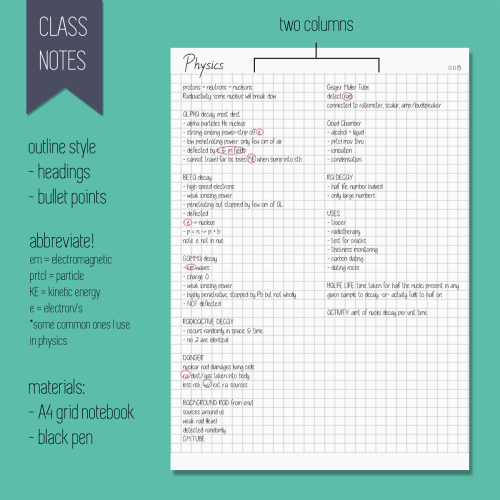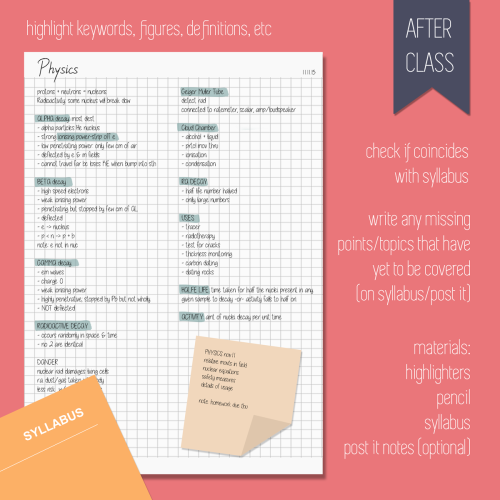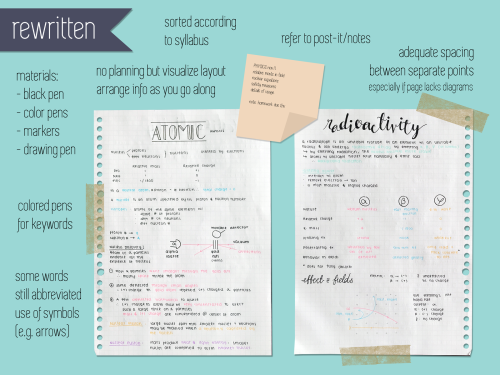29.05.17 • Day 1/30




29.05.17 • day 1/30
here’s the first page of my June spread and some bio notes I did today!!
will be aiming to achieve 30 days of productivity starting from today in preparation for mid-years right after June break ;-;
managed to review my bio test, watch an online holiday lecture and do up some notes today, let’s hope that I will continue being this productive!!! (۶•̀ᴗ•́)۶
More Posts from Swirlspill-study and Others
TOP 5 SITES FOR STUDENTS (a)
Gathered a few websites that I think would help you academically and financially!
Money Saving Expert - Started by Martin Lewis in 2003. Money Saving Expert bills itself as “dedicated to cutting your bills and fighting your corner through journalistic research, cutting-edge tools and a massive community”.
Cite This For Me - This site writes a bibliography and checks references so there’s no chance of being unjustly accused of plagiarism. It’s very frustrating to lose marks on an assignment for incorrect referencing.
Springboard Survey Panel - Students can join SpringBoard America Survey Panel to make their opinion count, and earn real cash and prizes for filling out surveys along the way.
Unidays - This is totally free to join, and used by over 4.3 million students every day. Signing up provides discounts on fashion, technology, music, stationary, food and more.
Opinion Outpost - Students sign up to complete surveys and give their opinion on various products and services for cash and prizes. Great way to earn a little side cash for books or clothes.




Note-Taking
Hey guys! So I’ve been receiving questions regarding my note-taking style and strategy for quite some time now but I believe I have never answered them in detail. The good news is, I finally decided to make a post about this (plus, I had fun making the graphics :D). Note that I am a visual learner, so my note-taking methods may not be effective for some of you, but I hope you can all learn something.
Class Notes
I only use one notebook for all my class notes, an A4 grid notebook whose pages I divide into two columns.
I use the outline method for in-class notes, which means I write information chronologically, in the order that they are taught. Some teachers do not have properly structured presentations/lessons (good thing my physics teacher does) so when in need, I use arrows to connect related information.
Abbreviations to me are one of the most important things to master when taking notes. I personally make them up as I go along. Some examples of abbreviations I use are:
w/c - which
w/ - with
cpd - compound
envt - environment
digenz - digestive enzyme
It might be confusing, but to me, knowing the context and part of speech are enough for all abbreviations to be comprehended.
Here’s an example: ‘Indonesia’s tsunami pre-warning system is made up of two types of components’ could become ‘Indo’s snmi pre-warn sys 2 type comp’.
After Class
The first thing I would do is highlight keywords and terminology (and sometimes formulas). For physics, since my teacher is relatively succinct, I don’t really highlight, but for humanities and biology, I look for words that would be expected by a mark scheme, words that are crucial to the understanding of each particular piece of information.
I would then check if the material taught coincides with the syllabus, and if not, note down any points that are missing or have yet to be taught. You could write these on a post it or on the syllabus itself, but I prefer to highlight the syllabus’ pdf file.
Rewritten Notes
My rewritten notes are arranged based on the order they appear in the syllabus unless there are pieces of information that are related to more than one topic.
I use a black pen for rewriting notes as well as colored pens to write keywords and terminology only. I know some people who write whole sentences in colored pens but to me that is ineffective; we all have our own learning styles. When making tables, I usually use different colors for different columns (see the table for different types of radiation above) which is most often the color I associate with each word. For example, water would be blue, ocean would be a darker shade, ice would be a lighter shade, and water vapor would be purple.
I still abbreviate words in my rewritten notes, but they’re not as condensed as the ones in my class notes. Another thing I find helpful is leaving a bit of space between separate points especially if the page doesn’t have a lot of diagrams. I can’t think linearly, so I can’t remember super lengthy bullet points.
I use mildliners and a drawing pen to make my diagrams (more of these in my biology notes) but I only start with pencil if it’s a complex diagram. I rarely highlight my rewritten notes, but even if I do, it’s usually only the headings and formulas.
I don’t have a rough draft for my notes, but I try to visualize the layout. I try to alternate between words and pictures/diagrams so that when I’m sitting for an exam, all I have to do is imagine that I’m looking at that page and I can remember where everything is.
Well, that’s all from me. I hope that this information could be of some use to every single one of you. Don’t hesitate to ask me questions if you’re confused about note-taking or any other problems you might have :)
Don’t Let Calculus D(e)rive You Mad
I was always one of those people who thought some people were naturally good at math and if I wasn’t one of those people then there was nothing I could do about it. I thought I wasn’t “a math person” and would use that description as an excuse. Is math one of my weaker subjects? Sure but that’s mostly because I let years of bad habits get in the way of my current work. This caught up to me in my first semester of calculus (calc I) at university, where calculus was my worst class. Here’s the thing: if you’re not “a math person” make yourself one. In my second semester of calculus (calc II) I improved my mark by an entire letter grade (something I never thought possible). How? Through hard work and by understanding that I would have to work harder than some people because of my past study habits.
Know your pre-calculus well! You will struggle so much if you forget the basics. My prof said not having a good grasp of the basics is the number one reason why students will struggle with calculus. Invest time before/at the beginning of the semester to really review the stuff you learned in high school. (Khan Academy is the best way to review, in my opinion. They have challenge questions you can do for each section. Try a couple of questions for each section. If you can’t answer the question easily, watch the accompanying videos for that section first. Do this for sections you forget or know you struggle with.) Be confident in your basic mental math too, especially under pressure. I wasn’t allowed a calculator on any of my midterms or finals for calc and you don’t want to waste time on easy math that you should know lightning fast anyway.
Attend every lecture, especially if you’re even slightly confused. If you’re behind, try not to get even more behind by skipping class (obviously use your own judgement, but don’t skip unless it’s totally necessary). Don’t sit near the back of the class if you know you won’t pay attention.
Don’t just sit there and copy down notes. Be attentive in class and follow along with examples the best you can. If you get lost at a certain step in a problem put a star beside it. After class, study and attempt the problem on your own. If you still don’t understand, go to a TA or prof for help. They will be able to provide better help if they can see exactly where you got lost.
Keep your notes simple. I would use either blue or black pen for the majority of my notes and use one other colour to emphasize parts of my notes (indicate where I got lost, circle important follows, highlight which section of the textbook the class was at, etc.) Keep your notes neat and leave a gap, if you fall behind during a lecture (just remember to get the notes from someone else later). I also recommend using a grid paper notebook, for when you need to draw graphs.
Get a mini notebook! I bought a tiny notebook for cheap and filled it with a (very) condensed version of my notes, throughout the semester. I wrote down common derivatives and integrals, shapes of common graphs, important theorems and formulas, etc. This is especially helpful for calc II, because you’ll have all the necessities from calc I handy.
Advice for using Maple for math labs (if this applies to you): Pay attention to tutorials and ask questions. Complete as many assignment questions as you can in the lab/when a TA is present. If you have any other assignment questions to finish up make sure you work on them at least a few days before they’re due, so you have time to ask for help if you need it. Also, Maple can be a stupid program. You could be missing just one number, letter, or symbol and it won’t work. Or you could have it exactly right and it still won’t work (retyping your input in a new worksheet usually helps). To remedy these issues, I would work on assignments with friends and compare what our worksheets looked like. Oh and TAs love if you give your variables funny names or change the colours of your graph, because they’re all nerds (and so are you, so embrace it).
Do as many practice problems as you can. Calculus is a class where you learn by doing. Do questions till you understand the concept. If problems are recommended, treat them as if they’re actually due (otherwise you’ll just tell yourself you didn’t have enough time to do any practice problems). My number one mistake was not doing enough practice problems and just assuming I knew how to answer the problem (if you can’t answer the entire question from start to finish, then you don’t actually understand the concept).
Please don’t fall behind. Stay on top of things and prioritize what needs to be done (i.e. treat practice problems from the chapter you just learned on equal footing with the lab report you have due – if you treat it as a priority, you will get it done). But, if you do fall really behind, don’t wait until it’s too late to ask for help. Just remember, there’s always something you can do (even if you feel like you don’t know anything and there’s not enough time for any practice problems before your midterm). Identify what you need to learn before you can do anything else (i.e. work on understanding basic integration before you try to do something more complicated like trigonometric substitution) and fit in as many practice questions as you can.
Don’t give up! If you don’t understand a concept right away you just have to keep trying! For practice problems, try to find an answer without looking at your notes. If you can’t figure it out from there, look in your lecture notes and textbook for any relevant formulas, examples, or similar questions. Try to answer the problem again. If you get it, be sure to fully complete another practice problem without any outside references. If you can’t figure out an answer then you should seek help from another person!
Don’t forget everything you learned at the beginning of the semester – review, review, review! Check out this explanation on the curve of forgetting. If you continually review what you learned, for only short periods of time, you will remember so much more and save yourself time in the end!
Utilize the resources available to you. I have a list of online resources at the end of this post, but don’t overlook what’s right in front of you. Go to your prof’s office hours, ask a TA for help, and take advantage of any tutoring or study groups. My uni has a math and science centre where upper year students are always available to help other students with practice problems. If you join a course union, they sometimes offer free tutoring.
Study in a productive environment. This varies by person but personally I need a quiet environment, with ideally no noise or only instrumental music, bright/natural lighting, and nothing to distract me (I hide my phone and only have one pen or pencil out). If you like to listen to music when you study, math is one of those subjects where you can listen to music with words.
Improve your test-taking skills. (1) On an exam, understanding a concept is no use if it takes you forever answer the question. Do lots of practice problems till you immediately know how to answer any kind of question. Speed can be key on exams. (2) My strategy is to flip through the exam booklet as I get it. I answer the questions I can do easily, first, and leave the really difficult ones till the end. (3) Show all of your work! Don’t lose marks because you didn’t show all of your work. (4) Expect your exams to be challenging and prepare accordingly. Overlearn the material. Prepare specifically for the exam by completing past exams/practice exams in an environment that mimics the test-taking environment.
Get every mark you can, because the little marks make a big difference. If you don’t know how to answer a question on an exam, write down any formula or theorem that could relevant. If you try to figure out a solution and know that it’s most likely incorrect, but don’t have enough time/knowledge to find the correct answer, just leave your work there (don’t erase it). There’s always a chance you could be on the right track or nice markers will give you a point or two for trying. Something is always better than nothing.
Focus on the applications of calculus (it’ll make the semester a whole lot more interesting)! A physics major won’t necessarily use calculus the same way a bio or chem major might, but that doesn’t mean some calculus isn’t useful for all of those majors to know. I’ve always planned to major in biology and looking ahead at classes I will need calculus for biostatistics and genetics classes. Never tell yourself something isn’t useful because then you’ll never treat it like it’s useful. Also, my prof taught a whole lecture about how calculus could be used to account for all the variables that could affect population if a zombie apocalypse ever happened, so obviously calculus has at least one really important use :)
Resources
A bit of advice: These are called resources for a reason. It’s okay once in a while to use some of the resources to find a full solution for a practice problem, but don’t abuse it. It is so so easy to just look up the answer but you’re only hurting yourself in the end.
Desmos (Online graphing calculator - I’ve made it through so far without actually buying a graphing calculator)
Khan Academy (Step by step videos and practice questions! You can go your own speed with the videos! My top recommendation!!!)
Paul’s Online Math Notes (If your prof doesn’t provide you with decent lecture notes, these ones are great!)
Symbolab (They have a calculator for derivatives, integrals, series, etc. and I like the way they split up the steps to solve.)
Slader (find your textbook on here and they’ll give you all the solutions to questions!)
Textbooks: I used the Single Variable Calculus: Early Transcendentals (8th edition, by James Stewart) and it was awesome. The way it was set up and all the examples really helped me (I just wish I had used it more)
This post by @quantumheels is seriously fantastic (and she has lots of good advice for other topics too, one of my favourite blogs)
My Other Posts:
AP lit tips, high school biology, how to ace intro psych, organization tips, physics doesn’t have to suck: how to enjoy and do well in your required physics classes, recommended reads, reminders for myself, using your time wisely on public transport, what i learned from university (first year), what i learned from high school
Quick reminder, especially for you younger undergrads: Discipline is a skill, not a character trait. And just like any skill, it can be practiced and improved upon incrementally. Try not to get discouraged if you have a day, or multiple days, where you are less disciplined than you would like or need to be. Don’t quit. Don’t spend the next week binging Netflix because you think it’s a hopeless endeavour. Just get up the next day and try again. Each day you try is more practice, and each day you practice, you’ll get a little bit better, and that continual improvement will pay dividends in the long run.
Keep at it.


Hot tea is refreshing to me the same way rain is. They both make me feel like I have a fresh start. I’m late again, but Day 11 of the April challenge by @journa
Academic writing advice inspired by Umberto Eco’s ‘How to Write a Thesis’:
Planning
Determine primary sources/bibliography.
Determine secondary sources/bibliography.
Find title.
Brainstorm a table of contents with as much detail as possible (with chapters, sections and even paragraphs and sub-paragraphs - see How to Write a Thesis’ own table of contents as an example at the end of this document) (if the first drafted table of contents is good enough, it will not be necessary to start the writing from the beginning).
Do a first draft of the introduction.
Note-taking and research
Use Google Scholar to make sure you do not miss important sources.
Keep the table of contents in mind when researching and take notes of which sources could go where.
While note-taking, differentiate which parts could be used as quotations from the ones that are simply important for the argument.
Eco underlines the importance of what he calls reading sheets, which can be understood as your notes on your readings. According to him, these should contain:
information about the author if he is not a well-known figure;
a brief (or long) summary;
they should mostly consist of quotations (accompanied by all the corresponding page numbers)
any commentaries you might want to add;
an indication of which part (or parts) of your table of contents the information mentioned belongs to.
Keep reading sheets on primary sources (which should be the longest) separate from those on secondary sources (which should only be 1-2 pages long).
In the end, re-read the notes and color-code all the different parts according to where they would fit in your table of contents.
Writing and editing
A good place to start would be by redrafting the introduction.
Define every key/technical term used/mentioned unless indisputably obvious.
General writing tips:
keep sentences short;
do not be afraid to repeat the subject twice (ex: Roberta went to the shop (…) Roberta bought carrots and tomatoes);
avoid excessive details;
avoid subordinate clauses (orações subordinadas);
avoid vague language;
avoid unnecessary adjectives;
avoid the passive voice.
While drafting, write everything that comes to mind. Leave the editing for the end.
Use your tutor as a Guinea pig. Make them read your first chapters (and, progressively, all the rest) well before delivery is due.
Ask for as much feedback as possible. Ask colleagues, friends and/or family to read your work. They will provide you with more diversified feedback, as well as allowing you to know if your writing is clear to anyone.
Stop playing ‘solitary genius’.
Don’t insist on starting with the first chapter. Start with what you know best and feel more comfortable writing about, then fill in the gaps.
Leave time for editing and try to take at least a one or two days long break in between writing and editing.
Do not forget to fill in the gaps. When you revisit your writing, go through it with all these writing tips in mind as well as a conscience of what your most common mistakes are.
Use Hemingway in the final editing phase.
Quotations and footnotes
Since there are two kinds of sources (primary and secondary), there are also two kinds of quotations: either we quote a text which we will interpret, or we quote a text which supports your interpretation.
Some quotation rules to know:
“Quote the object of your interpretive analysis with reasonable abundance.”
“Quote the critical literature only when its authority corroborates or confirms your statements. (…) when quoting or citing critical [aka secondary] literature, be sure that it says something new, or that it confirms authoritatively what you have said.”
“If you don’t want readers to presume that you share the opinion of the quoted author, you must include your own critical remarks before or after the passage.”
“Make sure that the author and the source of your quote are clearly identifiable.”
“When a quote does not exceed two or three lines, you can insert it into the body of the text enclosed in quotation marks. (…) When the quote is longer, it is better to set it off as a block quotation. In this case the quotation marks are not necessary, because it is clear that all set-off passages are quotes, and we must commit to a different system for our observations. (Any secondary developments [like the quote’s reference] should appear in a note.) (…) This method is quite convenient because it immediately reveals the quoted texts; it allows the reader to skip them if he is skimming, to linger if he is more interested in the quoted texts than in our commentary, and finally, to find them immediately when need be.”
Some footnote rules to know:
“Use notes to add additional supporting bibliographical references on a topic you discuss in the text. For example, ‘on this topic see also so-and-so.’”
“Use notes to introduce a supporting quote that would have interrupted the text. If you make a statement in the text and then continue directly to the next statement for fluidity, a superscript note reference after the first statement can refer the reader to a note in which a well-known authority backs up your assertion.”
“Use notes to expand on statements you have made in the text. Use notes to free your text from observations that, however important, are peripheral to your argument or do nothing more than repeat from a different point of view what you have essentially already said.”
“Use notes to correct statements in the text. You may be sure of your statements, but you should also be conscious that someone may disagree, or you may believe that, from a certain point of view, it would be possible to object to your statement. Inserting a partially restrictive note will then prove not only your academic honesty but also your critical spirit.”
“Use notes to provide a translation of a quote, or to provide the quote in the original language.”
How to Take Notes: from a Textbook
(Be sure to change the post type from link to text post when you reblog, if that’s what you want to do)
This method is best suited for textbook or article notes, and is a version of revised notes. It is also well suited for books you plan on returning to the bookstore or books you have rented, as it does not involve writing directly in the book itself.
First, you’ll need to find a notebook, and the pens you like the best. My favorite notebooks to work with for note-taking, especially for my “revised” notes, are the Moleskine, hard or soft cover, in size extra large. For this specific class (Intro to Gender and Women’s Studies), I decided that lined pages would suit my needs better. For my math, engineering, and science classes, I usually opt for squared paper, as I draw in lots of diagrams and graphs.
My favorite pens ever are Staedtler Triplus Fineliners, so even though they show through the pages a little bit, I still choose to use them. I just love the way they write. I usually write out my notes themselves with a Pilot G2 05 with black ink, as it writes with a finer line and doesn’t bleed through quite as much.
I usually try to set up my notebooks about a week or so before class starts, that way it’s ready to go on my first day of class.

You’ll want to start off by setting up your notebook. On my first page, I put my course code for my university, as well as the course title.

Next, and this is perfectly optional (I just like the way it makes the book look, especially at the end of the semester), I include some sort of related quote to the course. For my engineering courses (which are related to my major), I put a different quote at the beginning of each section. But as this is a two-month long course during the summer, I opted for one quote by Mohadesa Najumi at the beginning of my book.

Next I set up my table of contents and include a page with basic course information. As this course is all online, my course information just included the start and end dates of the course, what time content is posted and on what day, and the name of my professor. For my usual courses, I will include the days of the week the class meets on and where, TA names and contact info, as well as posted office hours for my professors and TAs and tutoring hours either in the library or in the College of Engineering.

Next is one of the things I’m most proud of.
While I religiously use my Erin Condren planner to map out my days, weeks, and months, I have found throughout my college experience that including monthly views for the months my class ranges has been helpful. This way, there’s no sifting through the multiple colors I have in my planner, and everything related to that class is in the same notebook.
On this calendar I include start dates of the class, the end date, the dates of exams or quizzes, assignment deadlines, office hours, etc.
For this course, as I just started a few days ago, I don’t have a lot of dates or information, so my calendars are still very empty.


Next up I go to my weekly overview. At the beginning of each week, I set up a weekly layout, and I include a list of assignments, tests, quizzes, tasks, projects, etc that need my attention throughout the week, and I place the days I plan on doing them or the days they need turned in onto the weekly layout.

Now you’re finally ready to get into taking the notes.
Gather your book, some sticky notes, and your favorite pen or pencil.
I color code my stickies so that the “revision” process later goes a bit smoother. In this case, I’m using blue to denote something interesting, intriguing, or thought provoking, greenish-yellow to represent the facts or important concepts, and pink for important vocabulary words and their definitions.

Read the selection once.
As you read along the second time, write notes on your stickies, and place them in a place of relevance directly on the page in the book. Just make sure you don’t cover up anything you need to keep reading.



Now, once you’ve read all the material in questions (you can choose to break it up however you want, but since Chapter 1 was assigned for the week, I’ve elected to break it into chapters), carefully remove your stickies one by one and lay them out on a flat surface. This is when having a separate color for vocab can be helpful, as I sometimes put all of my vocab at the beginning or end of a section, especially if the section of reading was particularly large.
Organize your stickies in an order that makes sense to you, and use this order as your basis for transferring those notes into your notebook. The order you choose can just be lumping them under similar headings. Some classes even lend themselves to a nice chronological order. Whatever you choose, just make sure it’s something that will make sense to you when you come back to it in the end.

Okay so up there I wasn’t following my own advice, I just thought I would include the picture because my handwriting looks nice…

Now organize the stickies!

Now you just start writing everything from the stickies into your notebook. I like to take each category or subgroup and put them in the book on the facing page, then put them back in my textbook as I finish with each post it.

Moving on to the next category.


Before you know it, you’ve written all of your stickies into your notebooks.

Now you’re revved up and ready to go. You can either keep going and make a note summary page (which I’ll show you next week), or you can leave it. These will also be helpful when reviewing for tests and quizzes. You can highlight or underline, or use even more stickies (which is what I usually do) as you review.
Well, that’s all I have for you right now. Happy studying!
(To view this post on wordpress, click here)
If you spend a lot of time on your laptop for work, study, etc., you should definitely check out this app called Noizio. It provides ambient background sounds that help calm you or keep you focused. You can even make and save your own combination of sounds. My personal favourite is winter wind + wind chimes + sea waves. Each sound’s volume can be adjusted individually as well!
-
 opligenra liked this · 1 year ago
opligenra liked this · 1 year ago -
 learnthehelloutathis liked this · 2 years ago
learnthehelloutathis liked this · 2 years ago -
 zabicci liked this · 2 years ago
zabicci liked this · 2 years ago -
 ariari221b liked this · 2 years ago
ariari221b liked this · 2 years ago -
 psychiclightloverpasta liked this · 3 years ago
psychiclightloverpasta liked this · 3 years ago -
 depressedtwin-likestvshowsalot liked this · 3 years ago
depressedtwin-likestvshowsalot liked this · 3 years ago -
 studist reblogged this · 3 years ago
studist reblogged this · 3 years ago -
 demjen liked this · 3 years ago
demjen liked this · 3 years ago -
 february-academia liked this · 3 years ago
february-academia liked this · 3 years ago -
 acidaminophen reblogged this · 3 years ago
acidaminophen reblogged this · 3 years ago -
 fearthehime liked this · 3 years ago
fearthehime liked this · 3 years ago -
 the-third-me liked this · 3 years ago
the-third-me liked this · 3 years ago -
 lifebuoyjournals reblogged this · 3 years ago
lifebuoyjournals reblogged this · 3 years ago -
 ekongbarry liked this · 3 years ago
ekongbarry liked this · 3 years ago -
 ghostystudies reblogged this · 4 years ago
ghostystudies reblogged this · 4 years ago -
 gabs199 liked this · 4 years ago
gabs199 liked this · 4 years ago -
 studywithisabel reblogged this · 4 years ago
studywithisabel reblogged this · 4 years ago -
 cresecentmoonwisdom liked this · 4 years ago
cresecentmoonwisdom liked this · 4 years ago -
 brenda-designs liked this · 4 years ago
brenda-designs liked this · 4 years ago -
 wannabemeowww liked this · 4 years ago
wannabemeowww liked this · 4 years ago -
 lunescomet liked this · 4 years ago
lunescomet liked this · 4 years ago -
 krruvp liked this · 4 years ago
krruvp liked this · 4 years ago -
 notetaeker reblogged this · 4 years ago
notetaeker reblogged this · 4 years ago -
 plansandcoffee reblogged this · 4 years ago
plansandcoffee reblogged this · 4 years ago -
 ghostystudies liked this · 4 years ago
ghostystudies liked this · 4 years ago -
 lil-hummus reblogged this · 4 years ago
lil-hummus reblogged this · 4 years ago -
 doggeddetermination liked this · 4 years ago
doggeddetermination liked this · 4 years ago -
 notes-by-saher liked this · 4 years ago
notes-by-saher liked this · 4 years ago -
 amitiangirl liked this · 4 years ago
amitiangirl liked this · 4 years ago -
 thesecretlifeofasarcasticgirl liked this · 4 years ago
thesecretlifeofasarcasticgirl liked this · 4 years ago -
 betterwithmochi liked this · 4 years ago
betterwithmochi liked this · 4 years ago -
 holiesterrain reblogged this · 4 years ago
holiesterrain reblogged this · 4 years ago -
 holiesterrain liked this · 4 years ago
holiesterrain liked this · 4 years ago -
 thesegraciposts liked this · 4 years ago
thesegraciposts liked this · 4 years ago -
 sweethanmochi liked this · 4 years ago
sweethanmochi liked this · 4 years ago -
 ahlace-louii reblogged this · 4 years ago
ahlace-louii reblogged this · 4 years ago -
 coffeecupstudyblr liked this · 4 years ago
coffeecupstudyblr liked this · 4 years ago
a study blog for collected references, advice, and inspiration
267 posts

